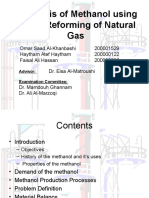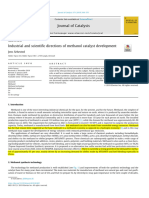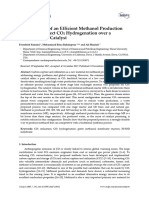System Approach Assignment
Uploaded by
Rohit ChauhanSystem Approach Assignment
Uploaded by
Rohit ChauhanMETHANOL SYNTHESIS IN A CASCADE FLUIDISED BED MEMBRANE CATALYTIC
REACTOR
Methanol is a bulk chemical, a kind of transportation fuel and energy material for fuel cell. It is a clean-burning
fuel with versatile applications. As a combustion fuel, it provides extremely low emissions.
Methanol is basically synthesized in three steps: Synthesis gas generation, Methanol synthesis and Methanol
distillation. The main step of methanol process is Methanol synthesis. Methanol is largely produced by natural
gas and specifically by means of syngas (CO and H2 mixture) obtained via steam reforming operations.
CO+2H2CH3OH
Impact on process: Implementing a higher temperature at the entrance of the reactor for a higher reaction
rate, and then reducing the temperature gradually towards the exit from the reactor for increasing
thermodynamic equilibrium conversion is one of the significant issues in methanol synthesis reactor
configuration. The configuration of dual-type reactor system permits high temperature in the first reactor and
a low temperature in the second reactor. In this system, the first reactor, isothermal water-cooled reactor, is
combined in series with a gas-cooled reactor, which accomplishes partial conversion of synthesis gas to
methanol.
Specifications of reactor:
Parameter Water-cooled reactor Gas-cooled reactor
Di (mm) 40.3 21.2
Tube length (m) 8 10
Shell side Pressure (bar) - 71.2
Tube side Pressure (bar) 75 76.
A schematic diagram of cascade fluidized-bed membrane methanol reactor (CFBMMR).
Process description: This system is mainly based on the two-stage reactor system consisting of a water-cooled
and a gas-cooled reactor, where both the reactors are fluidized-bed. The cold feed synthesis gas is fed to the
tubes of the gas-cooled reactor(second reactor)from top of the reactor and flowing in counter-current mode
with reacting gas mixture in the shell of the reactor. Moreover, the walls of tubes in this reactor(gas-cooled
reactor) consist of a hydrogen perm- selective membrane. The pressure difference between the shell and tube
sides is the driving force for diffusion of hydrogen through the Pd–Ag membrane layer. On the other hand, in
the new system, the mass and heat transfer process simultaneously occurs between the shell and the tube.
Then the outlet synthesised gas from the second reactor is fed to the bottom of tubes in the first
reactor(water-cooled)and the chemical reaction is initiated by the catalyst. In the first stage, methanol is partly
produced. Reacting gas leaving the first reactor is routed to the bottom of the second reactor. Finally, the
product is removed from the upstream of the second reactor (gas-cooled reactor).
Model Equations:
Model assumptions:
(a) The dense catalyst bed is considered to be composed of bubble phase and emulsion phase.
(b) The operation is assumed to be isothermal, which means bubble and emulsion phases have same
temperature.
(c) Plug flow regime in bubble phase is assumed.
(d) The bubble rise velocity is constant and equal to average value.
(e) Ideal gas behavior is assumed.
Mass conservation equation:
(∂yi/∂t) = (-δ/A)( ∂Fi/∂z) + δ.Kb.ct.a(yie-yib) + δ.γ.a
Where Kb is mass transfer coefficient between bubble phase and emulsion phase.
The heat transfer equation between tubes and shell side:
ct.cpg (dT/ dt) =(∏Di/ Ac) UTube ( Tshell-T)+(1- δ) n.a + δ.γ.n.a
Operational Complexity: Complex operation due to the presence of sensitive membrane.
Manufacturing Complexity: Requires highly modified techniques to build a membrane reactor.
Capacity: 5000 ton/day
Catalyst productivity: 0.3 kg CH3OH /kg cat/hr
Catalyst life: This method uses catalyst deactivation technique. The catalyst can be used till 1000
days with decrease in the catalyst activity.
Conversion: 40.8% for CO and 25% for CO2
Critical Analysis:
Advantages:
The simulation results represent good enhancement in the yield of methanol production during 1000
days of the operation in the cascade fluidized-bed membrane methanol reactor compared with
conventional dual type methanol reactor and even fluidized-bed membrane dual type methanol
reactor.
Low pressure drop.
Provides a uniform temperature along the reactor, which prolongs the service life of the catalyst.
In addition, in the reaction system, the addition of hydrogen to the reacting gas selectively leads to a
shift of the chemical equilibrium towards the product side, resulting in a higher methanol production.
Disadvantages:
Complex operation due to the presence of sensitive membrane.
Manufacturing Complexity.
Sensitivity of the membrane to heat.
Environmental Issues:
Disposal of membrane.
Emission of unconverted CO2 and CO to atmosphere must be checked.
References:
1. M.R. Rahimpour, M.Bayat, F.Rahmani; Dynamic simulation of a cascade fluidized-bed membrane
reactor in the presence of long-term catalyst deactivation for methanol synthesis.
2. M.R. Rahimpour, M. Bayat, F. Rahmani; Enhancement of methanol production in a novel cascading
fluidized-bed hydrogen perm-selective membrane methanol reactor.
3. Jean-Paul Lange; Methanol synthesis: a short review of technology improvements.
4. Francois Marechal, Georges Heyen, Boris Kalitventzeff; Energy savings in Methanol synthesis: Use of
heat integration techniques and Simulation tools.
You might also like
- Methanol Production From Syngas Reactor Design100% (2)Methanol Production From Syngas Reactor Design48 pages
- Methanol Production From Syngas Reactor Design100% (7)Methanol Production From Syngas Reactor Design41 pages
- Chemical Reactor: Click To Edit Master Subtitle StyleNo ratings yetChemical Reactor: Click To Edit Master Subtitle Style28 pages
- Modeling & Simulation of Methanol Synthesis From SyngasNo ratings yetModeling & Simulation of Methanol Synthesis From Syngas32 pages
- Processes: Methanol Synthesis: Optimal Solution For A Better Efficiency of The ProcessNo ratings yetProcesses: Methanol Synthesis: Optimal Solution For A Better Efficiency of The Process20 pages
- Httpsmdpi Res - Comd Attachmentprocessesprocesses 06 00020article Deployprocesses 06 00020.pdfversion 1519544708No ratings yetHttpsmdpi Res - Comd Attachmentprocessesprocesses 06 00020article Deployprocesses 06 00020.pdfversion 151954470820 pages
- Modelling in Methanol Synthesis: Control Engineering LaboratoryNo ratings yetModelling in Methanol Synthesis: Control Engineering Laboratory43 pages
- Hydrogenation of Carbon Dioxide For Methanol Production 2012 Chemical Engineering TransactionsNo ratings yetHydrogenation of Carbon Dioxide For Methanol Production 2012 Chemical Engineering Transactions6 pages
- Dynamic Simulation and Optimization of ANo ratings yetDynamic Simulation and Optimization of A12 pages
- Hydrogen Production TechnologiesFrom EverandHydrogen Production TechnologiesMehmet SankirNo ratings yet
- CRE Assignemnt Design of Fixed Bed ReactorNo ratings yetCRE Assignemnt Design of Fixed Bed Reactor13 pages
- Green Methanol Production Process From Indirect CO2No ratings yetGreen Methanol Production Process From Indirect CO257 pages
- Methanol From Natural Gas: Proven and New Technologies: WWW - Tue.nl/taverneNo ratings yetMethanol From Natural Gas: Proven and New Technologies: WWW - Tue.nl/taverne9 pages
- United States Patent (10) Patent No.: US 7,579,383 B2: Lattner (45) Date of Patent: Aug. 25, 2009No ratings yetUnited States Patent (10) Patent No.: US 7,579,383 B2: Lattner (45) Date of Patent: Aug. 25, 200914 pages
- Nhóm (Đ.Anh+ Hiếu + Ý) Syngas to MethanolNo ratings yetNhóm (Đ.Anh+ Hiếu + Ý) Syngas to Methanol40 pages
- Simulation of Methanol Production From Synthesis Gas: KeywordsNo ratings yetSimulation of Methanol Production From Synthesis Gas: Keywords14 pages
- Main_Ref_Optimal Conditions in Converting Methanol to Dimethyl EtherNo ratings yetMain_Ref_Optimal Conditions in Converting Methanol to Dimethyl Ether35 pages
- Process System Analysis CHEM2002: Simulation of The Methanol ProcessNo ratings yetProcess System Analysis CHEM2002: Simulation of The Methanol Process10 pages
- A Transient Study of Double-Jacketed Membrane Reactor Via Methanol Steam ReformingNo ratings yetA Transient Study of Double-Jacketed Membrane Reactor Via Methanol Steam Reforming9 pages
- Modeling and Simulation of Methanol Synthesis From Syngas75% (4)Modeling and Simulation of Methanol Synthesis From Syngas72 pages
- Membrane Reactor Engineering: Applications for a Greener Process IndustryFrom EverandMembrane Reactor Engineering: Applications for a Greener Process IndustryNo ratings yet
- Simulation of Methanol Production From Synthesis Gas PDFNo ratings yetSimulation of Methanol Production From Synthesis Gas PDF5 pages
- Sustainable Energy Conversion for Electricity and Coproducts: Principles, Technologies, and EquipmentFrom EverandSustainable Energy Conversion for Electricity and Coproducts: Principles, Technologies, and EquipmentNo ratings yet
- 2.4.1 Lurgi Low Pressure Methanol Synthesis ProcessNo ratings yet2.4.1 Lurgi Low Pressure Methanol Synthesis Process2 pages
- Development of An Efficient Methanol Production PRNo ratings yetDevelopment of An Efficient Methanol Production PR31 pages
- Chemical Engineering Journal: Contents Lists Available atNo ratings yetChemical Engineering Journal: Contents Lists Available at13 pages
- Kinetic Modeling of Methanol Synthesis Over Commercial - 2014 - Fuel ProcessingNo ratings yetKinetic Modeling of Methanol Synthesis Over Commercial - 2014 - Fuel Processing9 pages
- Applicant Guidelines: Newton-Bhabha Fund PHD Placement Programme 2020-21No ratings yetApplicant Guidelines: Newton-Bhabha Fund PHD Placement Programme 2020-2123 pages
- Test Method T220: Iron Unsoundness in Metallurgical SlagNo ratings yetTest Method T220: Iron Unsoundness in Metallurgical Slag4 pages
- Saint Mary's University - Criminology Review Center: Subject: Traffic Management & Accident InvestigationNo ratings yetSaint Mary's University - Criminology Review Center: Subject: Traffic Management & Accident Investigation7 pages
- LINK BUILDING - Find Guest Post OpportunitiesNo ratings yetLINK BUILDING - Find Guest Post Opportunities1 page
- Elsa Online. ElsaWin. ElsaWeb. VW1.6 L - 75 KW - Simos, Engine Code ALZ, From October 2000No ratings yetElsa Online. ElsaWin. ElsaWeb. VW1.6 L - 75 KW - Simos, Engine Code ALZ, From October 20001 page
- Universidad Nacional Abierta y A Distancia - UNAD Curso: INGLÉS B1+ Código: 9000No ratings yetUniversidad Nacional Abierta y A Distancia - UNAD Curso: INGLÉS B1+ Código: 90006 pages
- IMRAD Introduction Methods Results and Discussion 1No ratings yetIMRAD Introduction Methods Results and Discussion 12 pages
- ALGEBRAIC EXPRESSIONS Term 2 Lesson 7 Grade 8No ratings yetALGEBRAIC EXPRESSIONS Term 2 Lesson 7 Grade 85 pages
- First Quarter LP in English July 30, Filling Out FormsNo ratings yetFirst Quarter LP in English July 30, Filling Out Forms5 pages
- Human Resource Management Assignment Case Study - Job Analysis at Go-ForwardNo ratings yetHuman Resource Management Assignment Case Study - Job Analysis at Go-Forward11 pages
- La Danse, A Film by Frederick Wiseman 2009No ratings yetLa Danse, A Film by Frederick Wiseman 20095 pages


































































































